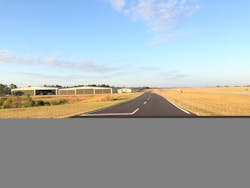Wiregrass Construction Co. Inc. Wins National Airport Paving Award
The National Asphalt Pavement Association (NAPA) announced Feb. 1, that Wiregrass Construction Co. Inc. of Pelham, Ala., has won the 2016 Ray Brown Airport Pavement Award for excellence in construction of an asphalt airport pavement. The company received its award at a ceremony during the association’s 62nd Annual Meeting in Orlando.
Wiregrass Construction Co. Inc. won the award for the mill and overlay of Bessemer Airport Taxiway Rehabilitation and Terminal Apron Rehabilitation Phase II. The project started in the spring of 2016, with the Bessemer Airport Authority asking for a complete rehabilitation of the airport’s apron, taxiway areas and airport hangars.
“It was very deteriorated,” said Mike Collins, airport manager with the Bessemer Airport Authority. “The surface was coming up, and it had surface cracks all throughout it. It was the original pavement; about 20–25 years old.”
“The runway was not part of this project’s rehabilitation, and it remained operational during the duration of the project,” said Jay Bryant, office manager for Wiregrass Construction. The company worked around the airport’s schedule of planes landing, taking off, and taxing.
One of the company’s top concerns was debris flying around during the milling process, so Wiregrass Construction aimed to work only when planes were not landing. This led to a bit of creative scheduling on the part of Wiregrass Construction and its many subcontractors. The company was required to give the airport authority 24-hours’ notice when milling was to take place, so accommodations could be made.
“We did it at some off times, when the airport was scheduled not to have the planes come in,” Bryant said. “But it was all during the daylight hours.”
The area was milled 1½ inches and replaced with a 19 mm P-401 surface course, required by the Federal Aviation Administration, for a total of 2,530 tons of asphalt used on the project.
“Wiregrass Construction worked with the Bessemer Airport Authority to complete the work in sections, so only certain taxiways would be closed at any given time,” Collins said. “We never had any area closed for more than one day,” Collins said. “So we had moved those aircraft to a different area, a ramp or another hangar so they could leave the next day and not be blocked in.”
Wiregrass Construction had six subcontractors working with the company at any given time, each completing a separate item of work. Wiregrass Construction repaired numerous joints and cracks in the taxiway and surrounding area, and then added crack sealant to affected areas.
Perhaps the biggest headache for Wiregrass Construction involved the concrete flumes used for drainage at the edge of the apron of the airport. Bryant said these flumes were massive and so steep that a person couldn’t even walk up or down them.
“To be able to rip that existing concrete out and then repour it — that was a significant battle,” Bryant said.
Bryant said both his company and the airport authority are pleased with the final product.
“We were able to vastly improve both the taxi apron and the taxi area of the airport,” Bryant said. “All the parties were completely satisfied with the joint work and getting those rehabilitated and back in working order.”
He said Wiregrass Construction was completely successful with its most worrisome task — to diminish the risk to aircraft during the rehabilitation work.
“Barricades were involved in keeping aircraft from being in the wrong place at the wrong time,” Bryant said. “The efforts of the milling crews were significant to make sure debris wasn’t flying, or something didn’t get out on the runway while it was closed and then found when the runway reopened 24 hours later. The cleanliness of the job was probably one of the most significant aspects of the project.”


